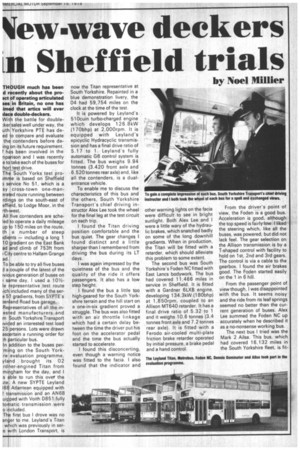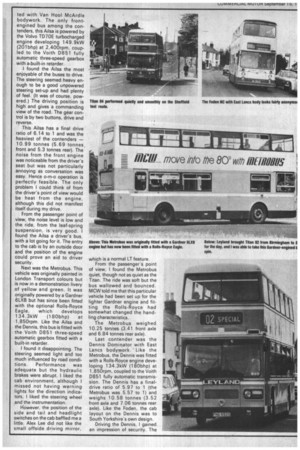ew-wave deckers Sheffield trials
Page 55

Page 56

Page 57

If you've noticed an error in this article please click here to report it so we can fix it.
by Noel Millier
THOUGH much has been
d r cently about the proSet f operating articulated SOS in Britain, no one has im ci that attics will ever Iac double-deckers.
Wit the battle for double:ker sales well under way, the uth Yorkshire PTE has deed o compare and evaluate th contenders before deing n its future requirement. h s been involved in the np rison and I was recently e to take each of the buses for hor test drive.
Th --South Yorks test pro
rn is based on Sheffield s rvice No 51, which is a sy cross-town one-man ra route running between rd i gs on the south-east of effi Id, to Lodge Moor, in the rthest.
All lye contenders are scheled o operate a daily mileage up o 150 miles on the route, th a number of steep dints — including a long 1 10 radient on the East Bank ad nd climb of 753ft from Ci y centre to Hallam Grange ad.
To e able to try all five buses a couple of the latest of the vi.us generation of buses on
s me day, I used a 101/2le epresentative test route Ich included many of the sere 5 gradients, from SYPTE's :en and Road bus garage.
Re resentatives of all the ines ed manufacturers and m outh Yorkshire Transport vi ed an interested test load 25 persons. Lots were drawn as rtain a running order for ;h articular bus.
In ddition to the buses per • ming on the South Yorkre evaluation programme, yland brought its 02 rd er-engined Titan from mi gham for the day, and I s ble to run this over the Jte A new SYPTE Leyland 16 Atl_ahtean equipped with ? t ansmission and an 4N68 ui ped with Voith D851 fully to atic transmission were oi cluded.
The first bus I drove was no anger to me. Leyland's Titan w'lich was previously in ser'e with London Transport, is now the Titan representative at South Yorkshire. Repainted in a blue demonstration livery, the 04 had 59,754 miles on the clock at the time of the test.
It is powered by Leyland's 510cuin turbo-charged engine which develops 126.8kW (170bhp) at 2,000rpm. It is equipped with Leyland's epicyclic Hydracyclic transmission and has a final drive ratio of 5.17 to 1. Leyland's fully automatic G6 control system is fitted. The bus weighs 9.94 tonnes (3.420 front axle and 6.520 tonnes rear axle) and, like all the contenders, is a dualentrance vehicle.
To enable me to discuss the characteristics of this bus and the others, South Yorkshire Transport's chief driving instructor Alex Lee took the wheel for the final leg at the test circuit on each trip.
I found the Titan driving position comfortable and the bus quiet. The gear changes I found distinct and a little sharper than I remembered from driving the bus during its LT days.
I was again impressed by the • quietness of the bus and the quality of the ride it offers passengers. It also has a low step height.
I found the bus a little too high-geared for the South Yorkshire terrain and the hill start on a one-in-six gradient proved a struggle. The bus was also fitted with an air throttle linkage which had a certain delay between the time the driver put his foot on the accelerator pedal and the time the bus actually started to accelerate.
I found this disconcerting, even though a warning notice was fitted to the facia. I also found that the indicator and other warning lights on the facia were difficult to see in bright sunlight. Both Alex Lee and I were a little wary of the hydraulic brakes, which snatched badly on some of the long downhill gradients. When in production, the Titan will be fitted with a retarder, which should alleviate this problem to some extent.
The second bus was South Yorkshire's Foden NC fitted with East Lanes bodywork. The bus had covered 11,466 miles in service in Sheffield. It is fitted with a Gardner 6LXB engine, developing 134.3kW (180bhp) at 1,850rpm, coupled to an Allison MT640 retarder. It has a final drive ratio of 5.32 to 1 and it weighs 10.6 tonnes (3.4 tonnes front axle and 7.2 tonnes rear axle). It is fitted with a Ferodo air-cooled multi-plate friction brake retarder operated by initial pressure, a brake pedal and a hand control.
From the driver's point of view, the Foden is a good bus. Acceleration is good, although the top speed is fairly low. I liked the steering which, like all the buses, was powered, but did not lack feel. The gear selection on the Allison transmission is by a T-shaped control with facility to hold on 1st, 2nd and 3rd gears. The control is via a cable to the gearbox. I found the air brakes good. The Foden started easily on the 1 in 6 hill.
From the passenger point of view though, I was disappointed with the bus. It seems noisy. and the ride from its leaf springs seemed no better than the Current generation of buses. Alex Lee summed the Foden NC up accurately when he described it as a no-nonsense working bus.
The next bus I tried was the Mark 2 Ailsa. This bus, which had covered 16,132 miles in the South Yorkshire fleet, is fit ted with Van Hool McArdle bodywork. The only frontengined bus among the contenders, this Ailsa is powered by the Volvo TD7OE turbocharged engine developing 149.9kW (201 bhp) at 2,400rpm, coupled to the Voith D851 fully automatic three-speed gearbox with asbuilt-in retarder.
I found the Ailsa the most enjoyable of the buses to drive. The steering seemed heavy enough to be a good unpowered steering set-up and had plenty of feel. (It was of course, powered.) The driving position is high and gives a commanding view of the road. The gear control is by two buttons, drive and reverse.
This Ailsa has a final drive ratio of 6.14 to 1 and was the heaviest of the contenders — 10.99 tonnes (5.69 tonnes front and 5.3 tonnes rear). The noise from the front engine was noticeable from the driver's seat but was not particularly annoying as conversation was easy. Hence o-m-o operation is perfectly feasible. The only problem I could think of from the driver's point of view would be heat from the engine, although this did not manifest itself during my drive.
From the passenger point of view, the noise level is low and the ride, from the leaf-spring suspension, is very good. I found the Ailsa a driver's bus, with a lot going for it. The entry to the cab is by an outside door and the position of the engine could prove an aid to driver security.
Next was the Metrobus. This vehicle was originally painted in London Transport colours but is now in a demonstration livery of yellow and green. It was originally powered by a Gardner 6LXB but has since been fitted with the optional Rolls-Royce Eagle, which develops 134.3kW (180bhp) at 1,850rpm. Like the Ailsa and the Dennis, this bus is fitted with the Voith 0851 three-speed automatic gearbox fitted with a built-in retarder.
found it disappointing. The steering seemed light and too much influenced by road conditions. Performance was adequate but the hydraulic brakes were abrupt. I liked the cab environment, although I missed not having warning lights for the direction indicators. I liked the steering wheel and the instrumentation.
However, the position of the side and tail and headlight switches on the cab baffled me a little. Alex Lee did not like the small offside driving mirror, which is a normal LT feature.
From the passenger's point of view, I found the Metrobus quiet, though not as quiet as the Titan. The ride was soft but the bus wallowed and bounced. MCW told me that this particular vehicle had been set up for the lighter Gardner engine and fitting the Rolls-Royce had somewhat changed the handling characteristics.
The Metrobus weighed 10.25 tonnes (3.41 front axle and 6.84 tonnes rear axle).
Last contender was the Dennis Dominator with East Lancs bodywork. Like the Metrobus, the Dennis was fitted with a Rolls-Royce engine developing 134.3kW (180bhp) at 1,850rpm, coupled to the Voith D851 fully automatic transmis sion. The Dennis has a finaldrive ratio of 5.97 to 1 (the Metrobus was 5.57 to 1) and weighs 10.58 tonnes (3.52 front axle and 7.06 tonnes rear axle). Like the Foden, the cab layout on the Dennis was to South Yorkshire's own design.
Driving the Dennis, I gained an impression of security. The bus felt safe and predictable. The acceleration did not seem startling, but it was good enough. The brakes and steering were good. As this particular bus had covered only 1,854 miles the engine was possibly still a little tight.
A retarder was fitted with a hand control in addition to the foot control, and was particularly effective.. The bus started easily on the 1 in 6 hill. The air brakes were positive but not too abrupt.
The radiator fan was particularly noisy and cut in at normal running temperatures and would cause driver and passengers annoyance. However, this was probably due to incorrect fitting by the bodybuilder which had been temporarily corrected by the PTE engineer and normally would not be so ,:oticeable.
I found the driving seat on this bus a little hard compared with those of the other contenders. From the passenger point of view, engine noise levels are reasonable and the ride from leaf springs excellent. A quick drive in the type AN68 showed graphically the progress made by the new generation over the previous one and the superiority of the Voith transmission performance and ride characteristics over the standard Atlantean transmission.
Finally, a quick drive in the Gardner-engined Titan gave me an added impression of Leyland's contender. The Gardner version seemed quiet, although noisier than the Leyland-engined version. The brakes still snatched, however, although the improved instrument panel makes it easier to see the warning light in bright sunlight.
Initial fuel consumption figures taken on general service running, not taking into account speedometer error, show how closely matched the contenders are. In the lead is the Titan which returned 42.7 lit/100km (6.62mpg), second is the Metrobus 46.7 lit/100km (6.05mpg), third the Foden, 47.2 lit/100km (5.98mpg), fourth the Dennis, 52.5 lit/ 100km (5.38mpg), and fifth the Ailsa Mk 2 with 53.0 lit/100km (5.33mpg).
Fuel consumption is only part of the battle and the next few months will show the buses' paces to a greater extent. From the passenger point of view, I would put the quiet and smooth-riding Titan number one, with the Dennis second and the Ailsa third. The Metrobus, too, is a great improvement on the present generation, although the Foden is as good as the present generation. The ride in particular seems no better.
From the operator's point of view, the Foden and the Ailsa have both proved reliable in service. The Dennis, Titan and Metrobus have not been in service in Sheffield so long but will no doubt prove their worth.
Whatever the outcome of their comparative tests, South Yorkshire PTE will take into consideration all aspects of the new buses, including technical and mechanical assessment of vehicle specifications, vehicle performance and evaluation of passenger and driver compatibility of each design. The PTE already has 50 Metrobuses on order, but the announcement of its 1979 vehicle order is awaited eagerly by manufacturers throughout the country.
Full evaluation of the designs should ensure that the people of South Yorkshire receive the best possible bus service from the most suitable buses for their terrain in the years to come.




























































































































